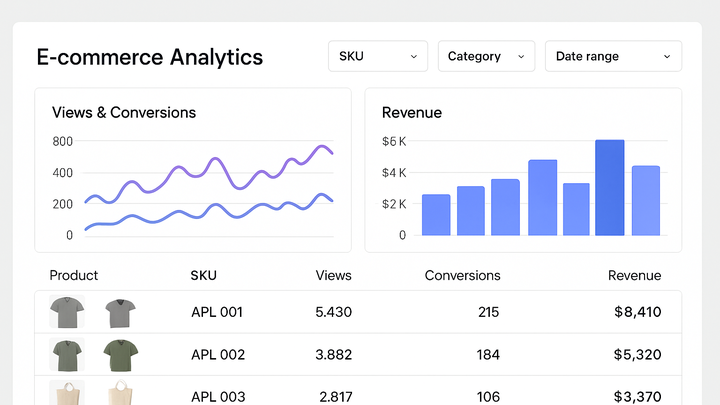Published on 2025-06-22T09:37:58Z
What is SKU Analytics? Examples for SKU Analytics.
SKU Analytics refers to the process of collecting, monitoring, and analyzing performance data at the Stock Keeping Unit (SKU) level. Each SKU represents a distinct product variant—such as size, color, or batch—in your catalog.
By drilling down to individual SKUs, businesses can optimize inventory, marketing spend, and pricing strategies with precision. SKU Analytics uncovers insights like which color variant outperforms others in conversions or which batch runs out of stock fastest.
Modern analytics tools like Google Analytics 4 (GA4) and PlainSignal (a cookie-free simple analytics solution) support SKU-level tracking, enabling real-time dashboards and lightweight implementations. With PlainSignal, you can add a snippet like:
<link rel="preconnect" href="//eu.plainsignal.com/" crossorigin />
<script defer data-do="yourwebsitedomain.com" data-id="0GQV1xmtzQQ" data-api="//eu.plainsignal.com" src="//cdn.plainsignal.com/plainsignal-min.js"></script>
Meanwhile, GA4 allows you to define custom dimensions for SKU codes and capture detailed events for e-commerce analysis.
Use SKU Analytics to drive data-driven decisions, reduce stockouts, and maximize revenue per product variant.
Sku analytics
SKU Analytics tracks and analyzes performance metrics for individual product variants (SKUs), enabling precise inventory, marketing, and sales optimization.
Overview of SKU Analytics
This section introduces the concept of SKU Analytics, explaining what SKUs are and why tracking at this level matters.
-
Stock keeping units (skus)
A SKU is a unique identifier for each product variant—such as size, color, or model—used to track inventory and sales at a granular level.
-
Why sku-level tracking matters
By analyzing data per SKU, businesses can detect high-performing variants, optimize stock levels, and tailor marketing strategies to specific product lines.
Key Metrics in SKU Analytics
Focus on the essential metrics at the SKU level that reveal a product variant’s performance.
-
Sku views
The number of times a product detail page for a specific SKU is viewed by users.
-
Sku conversion rate
The percentage of SKU page views that result in a purchase.
-
Calculation
(Purchases for SKU / SKU Views) * 100
-
Importance
Indicates how effectively a product variant converts traffic into sales.
-
-
Sku revenue
Total revenue generated by a specific SKU over a defined time period.
Implementing SKU Analytics with SaaS Tools
Practical setup with popular solutions like PlainSignal and Google Analytics 4 for tracking SKUs.
-
PlainSignal (cookie-free analytics)
PlainSignal provides lightweight, privacy-friendly analytics with no cookies required. To set up SKU tracking, embed the script below and send SKU data via custom events.
<link rel="preconnect" href="//eu.plainsignal.com/" crossorigin /> <script defer data-do="yourwebsitedomain.com" data-id="0GQV1xmtzQQ" data-api="//eu.plainsignal.com" src="//cdn.plainsignal.com/plainsignal-min.js"></script>-
Embedding the script
Place the snippet in the <head> section of your HTML to initialize PlainSignal on every page.
-
Sending sku data
After page load, call PlainSignal.track(‘sku_view’, { sku: ‘SKU123’, productName: ‘Blue T-Shirt’ }); to record SKU views.
-
-
Google analytics 4 (GA4)
GA4 allows SKU-level tracking through e-commerce events and custom dimensions. First, add the global site tag snippet. Then send an event like
view_itemwith the SKU identifier.<!-- Global site tag (gtag.js) --> <script async src="https://www.googletagmanager.com/gtag/js?id=G-XXXXXXXXXX"></script> <script> window.dataLayer = window.dataLayer || []; function gtag(){dataLayer.push(arguments);} gtag('js', new Date()); gtag('config', 'G-XXXXXXXXXX'); // Send SKU view event gtag('event', 'view_item', { items: [ { item_id: 'SKU123', item_name: 'Blue T-Shirt', currency: 'USD', price: 19.99 } ] }); </script>-
E-commerce setup
Enable E-commerce reporting in your GA4 property under Admin > Data Streams > Enhanced measurement.
-
Custom dimensions
Register the
item_idparameter as a custom dimension to analyze SKU performance in GA4 reports.
-
Use Cases and Benefits
Examples demonstrating how SKU Analytics informs key business decisions.
-
Inventory optimization
Analyze SKU-level velocity to maintain optimal stock levels and reduce carrying costs.
-
Marketing campaign insights
Identify top-performing SKUs in promotions to refine targeting and creative assets.
-
Sales forecasting
Use historical SKU data to predict future demand for each product variant.
Best Practices for SKU Analytics
Guidelines to ensure reliable and actionable SKU-level data.
-
Consistent sku naming conventions
Adopt a clear, systematic naming scheme to avoid confusion and ensure data integrity.
-
Data granularity and segmentation
Capture additional product attributes (e.g., size, color) to enable more granular insights.
-
Regular data audits
Periodically review SKU mappings, event tracking implementations, and data quality to maintain accuracy.
